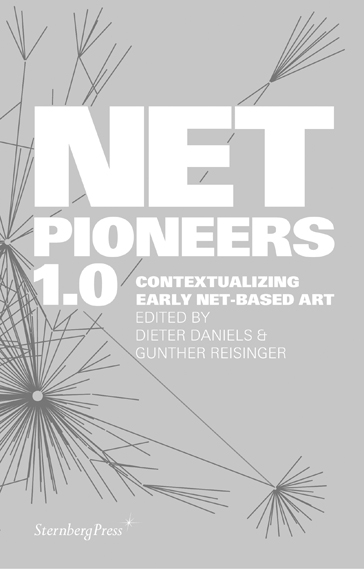Annet Dekker (ed.): Archive2020 – Sustainable Archiving of Born-Digital Cultural Content (2010)
Filed under book | Tags: · archive, archiving, born-digital art, database, digital art, media art, preservation

The term ’born digital’ is closely related, maybe even synonymous, with the term ‘natively digital’. This term is often used as reference to the object of study in the academic research of the Internet that gives focus to digital methods. In other words, research strategies that follow the specifics of the Internet as a medium. In this context the term refers to digital materials that are specific, and/or born into the Internet, like the link and the tag, and devices, like search engines, and opposed to those materials that have migrated to it, in other words, have been digitally reformatted.
“We have asked several stakeholders from different disciplines to write down their experiences, findings and solutions. These specialists from the area of born-digital preservation and archiving reflect on the current state of affairs in their specific field and identify the most pressing concerns. Established Internet artist Martine Neddam elaborates on the challenges an Internet artist faces over the years, from domain name registration expirations, to database back-ups, recent updates and much more. Researchers and artists Anne Laforet, Aymeric Mansoux and Marloes de Valk explain the benefits of using FLOSS and open standards for preserving born-digital material. Florian Cramer, lecturer at the Piet Zwart Institute in Rotterdam, reflects on the PRINT/pixel international conference that was organized in May 2009, and discusses the issue of digital print material. Departing from the closure of two important advocates for media art preservation – the Daniel Langlois Foundation and the Ludwig Boltzmann Institute – Canadian researcher and writer Caitlin Jones focuses on the issue of responsibility for keeping our media art heritage alive. Gaby Wijers, head of Collection and Conservation at NIMk, Amsterdam and Gabriele Blome, art historian, University of Siegen, Germany, shed light on the first internationally shared online archive GAMA – the Gateway to European Media Art. Australian curator and researcher Lizzie Muller draws attention to the importance of capturing audience experiences when dealing with the preservation of born-digital cultural material. Jeroen van Mastrigt, lecturer at the Art, Media and Technology Faculty of the Utrecht School of the Arts (HKU-KMT) in Hilversum, discusses archiving strategies in gaming.”
Compiled and edited by Annet Dekker
with chapters by Annet Dekker, Martine Neddam, Anne Laforet, Aymeric Mansoux, Marloes de Valk, Florian Cramer, Caitlin Jones, Gabriele Blome, Gaby Wijers, Lizzie Muller, Jeroen van Mastrigt, Maurits van der Graaf, Gerhard Nauta
Publisher Virtueel Platform, Amsterdam, 2010
Creative Commons BY-NC-ND 3.0 NL License
ISBN 9789490108045
112 pages
PDF (6 MB, updated on 2015-9-26)
Issuu
See also Speculative Scenarios, or What Will Happen to Digital Art in the (Near) Future?, 2013.
Comment (0)Dieter Daniels, Gunther Reisinger (eds.): Net Pioneers 1.0: Contextualizing Early Net-Based Art (2010)
Filed under book | Tags: · 1990s, art history, art theory, internet, internet art, media art, net art, network society, new media art

“Net Pioneers 1.0 discusses media art history with a new, interdisciplinary look at the historical, social, and economic dynamics of our contemporary, networked society.
The hype around Net-based art began in the early 1990s, before the Internet had become a commodity. It developed in skeptical parallel to the rise and decline of the new economy. But why does this chapter of art history appear to end so suddenly? Is it that the idea of Net-based art involving itself in a revolutionary spirit in a networked society failed? One might equally well argue that it was far too successful simply to become another media-art genre. Looking today at the social, aesthetic, and conceptual approaches of the early 1990s presented in this book, it is clear that most of them have in fact come true, if in ways other than intended.
The contributions cover a wide variety of topics, ranging from art-scholarly methodological debate (Bentkowska-Kafel, Kuni), source-critical analysis (Reisinger), archiving, exhibition, and analytical practice (Ernst, London, Paul, Sakrowski) to media-philosophical aspects (Ries) and technical and artistic innovations (Daniels).”
Contributions by Anna Bentkofska-Kafel, Dieter Daniels, Wolfgang Ernst, Verena Kuni, Barbara London, Christiane Paul, Gunther Reisinger, Marc Ries, Robert Sakrowski and Julian Stallabrass.
Publisher Sternberg Press, Berlin and New York, February 2010
Co-published with the Ludwig Boltzmann Institute Media.Art.Research
ISBN 978-1-933128-71-9
240 pages
Publisher
Co-publisher (archived)
PDF (index missing; updated on 2018-11-27)
PDFs
Networked: a (networked_book) about (networked_art) (2010, open draft)
Filed under wiki book | Tags: · collaboration, media art, network art, network culture, networks, participatory culture

In 2007, Jo-Anne Green and Helen Thorington (Co-Directors, New Radio and Performing Arts, Inc. | Turbulence.org) proposed Networked to Eduardo Navas (NewMediaFIX). Along with Sean Dockray (Telic Arts Exchange) and Anne Bray (Freewaves), they developed an application to the National Endowment for the Arts, which funded the project in 2008.
An international Call for Proposals was issued. It defined the project’s Goals and Objectives and invited contributions that critically and creatively rethink how networked art is categorized, analyzed, legitimized — and by whom — as norms of authority, trust, authenticity and legitimacy evolve. A committee of nine reviewed the submissions: four authors were commissioned to develop chapters that are now open for commentary, revision, and translation. A fifth — one of the runners-up — was invited to contribute. Networked is open to additional chapters.
Networked proposes that a history or critique of interactive and/or participatory art must itself be interactive and/or participatory; that the technologies used to create a work suggest new forms a “text” might take.
Chapters:
* Remix and the Rouelles of Media Production
* Deseriis › No End In Sight
* Ulmer › The Learning Screen
* Varnelis › The Immediated Now
* Helmond › Lifetracing
* Freeman › Storage in Collaborative Networked Art
* Munster › Data Undermining
* Lichty › Art in the Age of DataFlo
by Authors and Collaborators of the Networked Book Project.
Facilitator: New Radio and Performing Arts, Inc. (NRPA).
Licensed under a Creative Commons Attribution-Noncommercial-Share Alike 3.0 Unported license.

